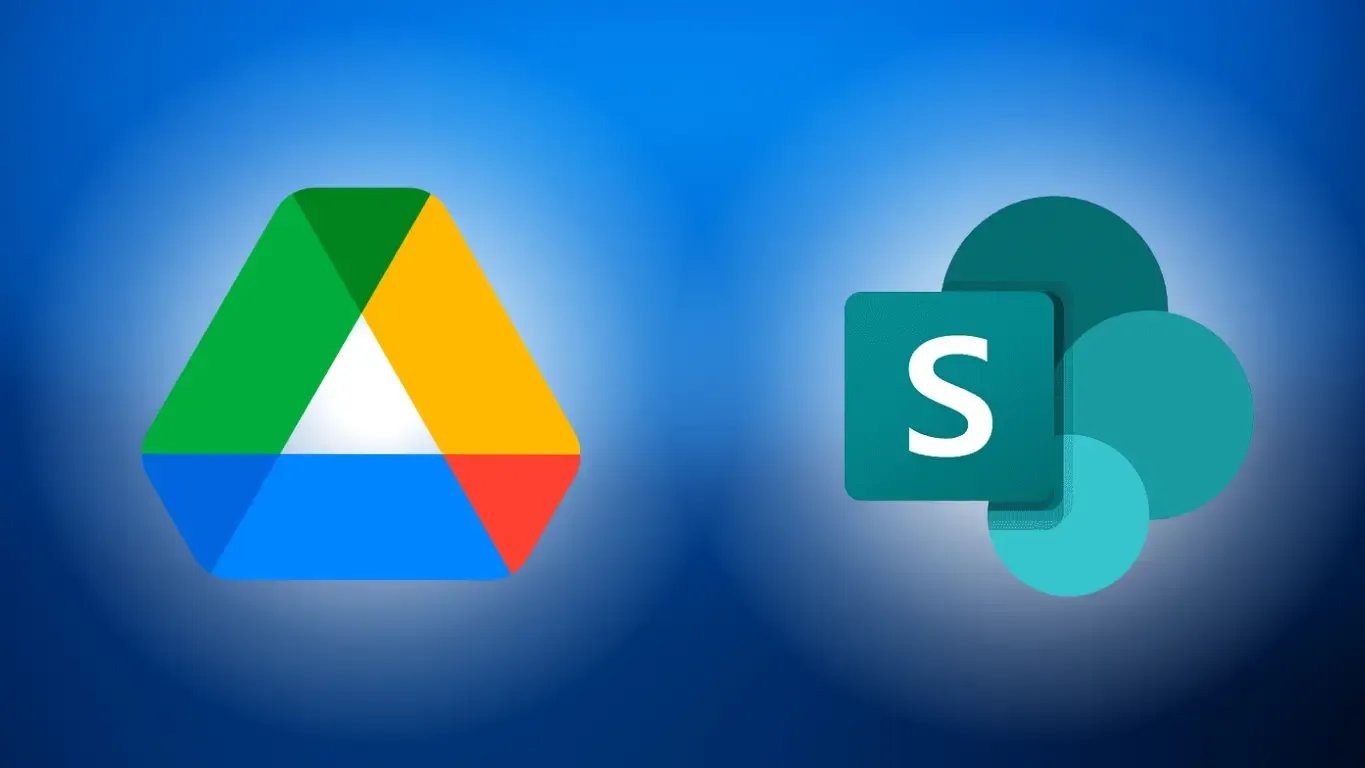Comparing Google Drive to SharePoint
Your business needs an IT platform that allows its team members to share and store data while also collaborating on various projects The question the...

Your business needs an IT platform that allows its team members to share and store data while also collaborating on various projects. The question then becomes: which platform is the best for your organization? Two popular and commonly used content and document management platforms are Microsoft SharePoint and Google Drive. Both have advantages and disadvantages associated with them. One is a better choice for the majority of organizations, regardless of size, sector, or maturity.
Google Drive vs. SharePoint
First, it may help to look at how the two systems differ. Microsoft SharePoint exists in the Microsoft ecosystem of applications. Its intent is to enable greater productivity and collaboration within an organization. It allows its users to manage content and documents on the Microsoft Office 365 platform. Users can access it via a web browser or their desktop along with other Microsoft O365 applications.
Google Drive exists within the Google Suite of IT solutions. It’s a cloud-based document management platform operated by Google that allows for file storage of various formats. For collaboration, companies can use Google Docs. This allows users to create new files (in a variety of Google-supported formats such as documents or spreadsheets). It also allows users to give access to other users so they can edit the document.
While both systems offer similar capabilities, there are a number of reasons why many users should migrate their data and collaboration from Google Drive to Office 365. Let’s take a closer look at why Microsoft’s solution offers a clear-cut advantage over Google’s offerings. Of course, every organization is different and needs can vary. But there’s a compelling argument that most businesses would stand to benefit from a migration from Google to SharePoint.
Additional Services
The key to identifying the right platform for your organization’s specific needs? Determining the baseline capabilities the platform has to allow you to both 1) manage and store content and 2) share content for editing. While both platforms allow its users to manage their content, SharePoint offers more capabilities in doing so. Consider the following:
- With SharePoint, you can create lists and establish a workflow. This allows you to better manage your team’s ability to complete work. This helps your team take the next step in collaboration - you move from simply providing access to documents to being able to actively manage the collaboration. You can monitor the workstream and ensure that everyone is hitting their targeted goals and staying on schedule.
- You can integrate SharePoint with other Microsoft applications. Your business may use multiple Microsoft applications to get work done and may need to move data between apps at times. SharePoint enables you to do this. For example, if you’re team communicates and collaborates using Microsoft Teams, data or documents used in either platform are able to be easily transferred to the SharePoint. This also helps for recordkeeping purposes - if you find your content spread across various Microsoft applications, you’ll need an easy way to transfer it from one app to another.
- SharePoint essentially functions as a shared drive, making it a solution better fitted for employees sharing documents. This opens up a world of possibilities for company-wide collaboration. It makes it easier for your team members to share documents within their department or with other departments. You have the ability to control who has access to each sub-portal.
Google Suite
While the Google Suite does offer capabilities similar to SharePoint, there’s no ability for users to store files to a shared drive. This makes collaboration (especially between users on disparate teams) somewhat more difficult. It’s not impossible, but it’s also not as seamless. You’ll need to spend time finding workarounds or using alternate platforms, specifically for file sharing. SharePoint lets you keep everything under one virtual roof.
Security
 Businessman sitting by the desk and analyzing project timeline
Businessman sitting by the desk and analyzing project timeline
Maintaining proper data security is paramount to any organization, particularly when you’re sharing and storing proprietary information. Failure to do so can severely impact an organization in a negative way when data falls into the hands of malicious actors. Phishing scams, ransomware, and other cybersecurity threats have the ability to do significant damage to your operations if they aren’t guarded against. That’s why keeping your content secure should be one of your first concerns, no matter what how much and what kind of content your organization is sharing. Your content and document management platform needs to be equipped to handle potential data breaches. When it comes to securing your data, SharePoint has an advantage over Google. SharePoint offers:
- Encrypted connections
- SMTP ports
- SMTP encryptions
Remember, Microsoft deals with licenses as opposed to personal user data. For the licenses it offers, the personal and business information associated with each license is offered greater security and protection. Google Drive ties to personal accounts. When an employee leaves your company, you may be unable to access data they have stored in Google Drive. With SharePoint, the data is tied to the license. There won’t be any lag in accessing information from an employee being offboarded. SharePoint offers heightened security capabilities and greater flexibility in managing expired or departing users.
Price
When it comes to any program, system, or resource, pricing is an important factor. Taking the cost into consideration helps you stay on budget. That doesn’t necessarily mean the lowest price is always the best option, however.
Goggle Drive
When it comes to affordability, Google has the edge on SharePoint. But it’s also important to remember that you get what you pay for, and many of the capabilities SharePoint offers are worth the additional funding you may invest in it. When you take a look at the pricing for both plans, the lowest number may not be representative of the most attractive option. The pricing for Google’s plans are as follows:
- Basic: $6 per month
- Business: $12 per month
- Enterprise: $25 per month
With the Business and Enterprise plans, you have access to unlimited cloud storage.
SharePoint
SharePoint’s pricing is structured somewhat differently than Google’s. For one, you will spend more money. Your SharePoint plan will also depend on the number of users as well as the number of Microsoft O365 applications used as part of your package. There are also different storage levels that differentiate the plans. Below are the various SharePoint plans and their associated costs:
- SharePoint Plan 1: SharePoint, OneDrive, 1 TB of OneDrive storage per user for $5 a user a month
- SharePoint Online Plan 2: SharePoint, OneDrive, unlimited cloud storage for $10 a user a month
- O365 Enterprise E3: All the previously listed components combined with all O365 applications and no limit to the number of users for $20 a user a month
As noted above, there’s no question who presents the cheaper option. But the question you’ll need to ask yourself as your company explores a data storage solution: are the additional capabilities afforded by SharePoint worth the slightly higher costs associated with it? Or, put another way: are the savings offered by Google Suite enough to cover up from potential storage gaps that SharePoint may solve?
It’s also important to think in terms of short- and long-term spending. For example, going for the cheaper option may save money in the short-term. But what if that option compromises your data security? It could lead to untold costs down the line. Or if the collaboration features aren’t sufficient to what your organization needs, it could lead to a less than ideal productivity levels.
Investing in a more comprehensive platform can offer better long-term savings by being a better overall tool for your organization.
Conclusion
The bottom line is that while Google Suite offers the advantage of being lower cost, the many advantages offered by SharePoint greatly outweigh the savings. Below is a summary of the advantages of SharePoint over Google:
- Your company can scale more easily with SharePoint.
- SharePoint allows you to opt for plans that include other Microsoft O365 applications that can also help your organization function better.
- SharePoint’s security features protect against data theft and phishing.
- Your users can access SharePoint data at any time, at any location.
As noted above, Google does offer the most cost-friendly offering. If your organization has minimal resources to dedicate to file storage and collaboration, Google may seem like the more attractive option. However, it’s also important to note that SharePoint’s pricing isn’t cost-prohibitive. Also, if one views the higher cost as an investment in long-term savings through access to enhanced capabilities, the decision may become a bit easier.
For a more comprehensive and holistic approach to data storage, your organization should look to migrate from Google Drive to SharePoint. SharePoint quite simply offers a platform better equipped for organizational collaboration.
Microsoft SharePoint should be your company’s go-to platform for data storage and collaboration. You should take extra care when migrating, however, to ensure all documents and content are transferred effectively. To determine how to migrate, you should partner with a trusted IT provider who understands the finer points of both platforms. Agile IT can be that partner. For more on how to migrate your systems from Google to SharePoint, request a quote today.





